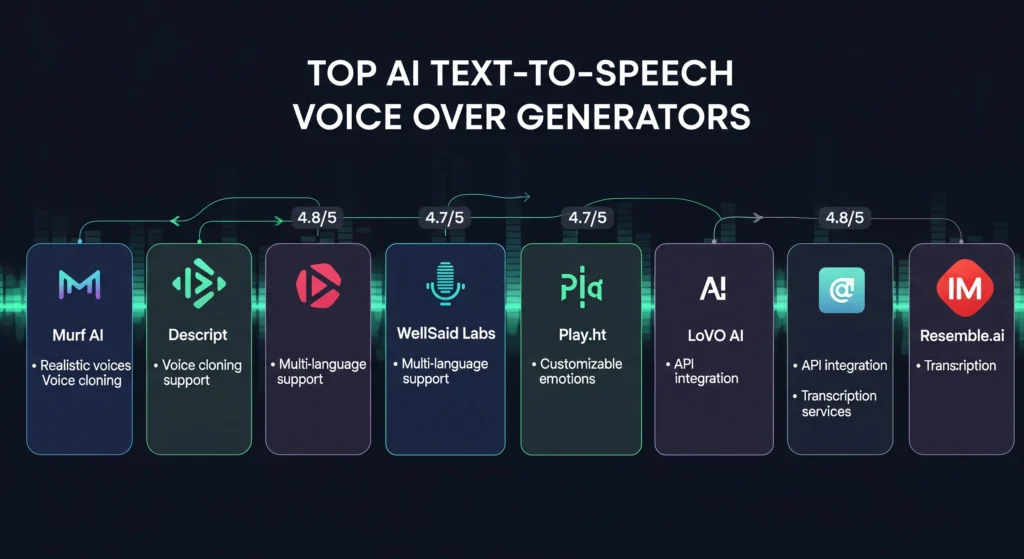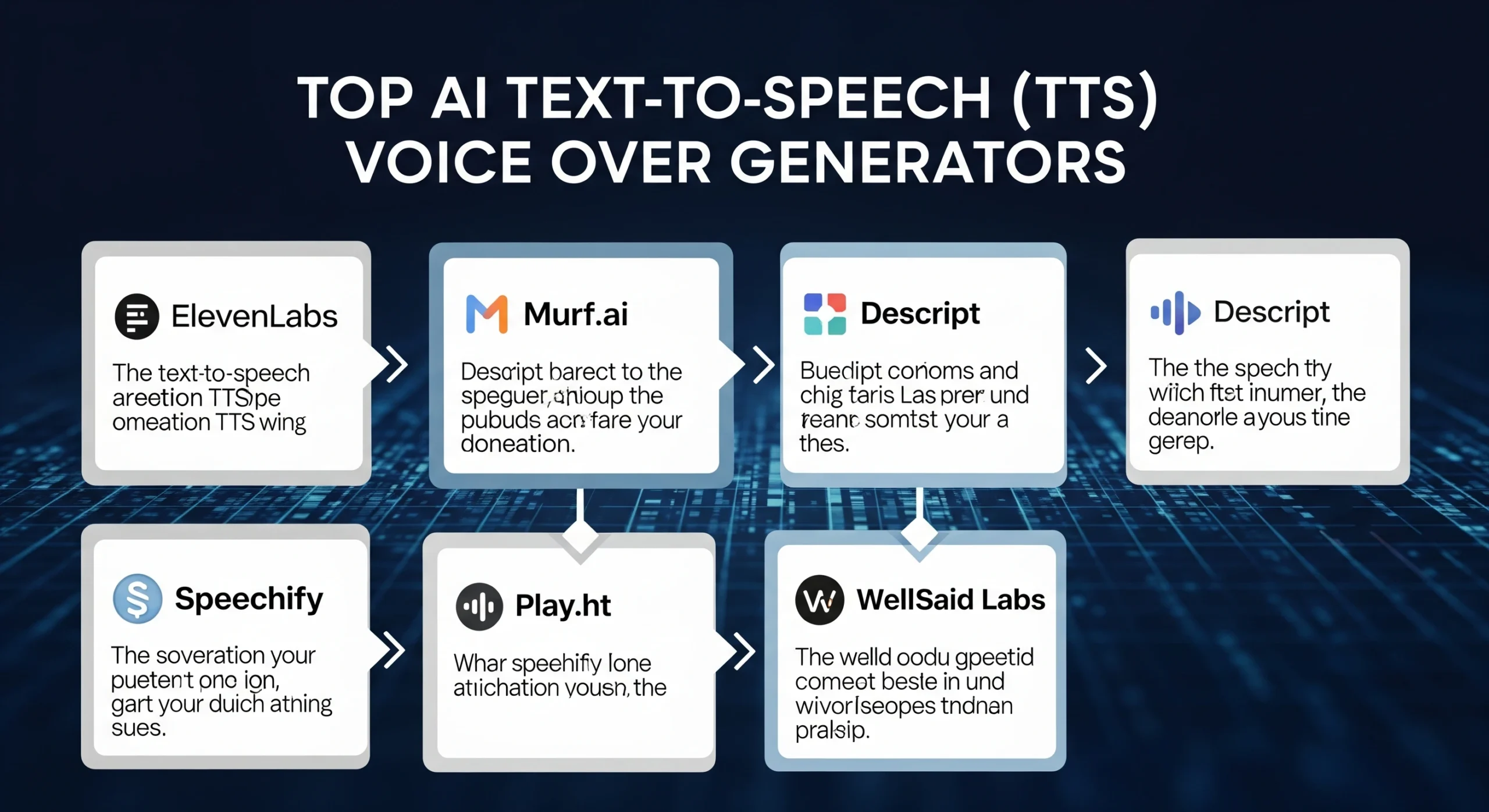AI Text-to-Speech (TTS) Voice Over Generators tools have reached near-human levels of realism, with advanced features like voice cloning, emotional inflection, multilingual support, and integration for video/podcasts.
Text-to-Speech AI Voice Over Generators
The best options excel in naturalness, customization, and ease of use for AI voice overs in YouTube videos, audiobooks, e-learning, podcasts, and marketing.
Based on extensive reviews, benchmarks, and user feedback from sources like Zapier, eWeek, Medium, Unite.AI, and Reddit communities, ElevenLabs stands out as the overall best for most users due to its hyper-realistic voices, superior voice cloning, and expressive control.

It consistently ranks #1 in blind tests for naturalness and emotion. Here’s a detailed comparison of the top 7 tools for your referance:
10 Text-to-Speech AI Voice Over Generators
1. ElevenLabs — Best for Overall Realism and Voice Cloning
As of 2025, ElevenLabs is widely regarded as the most advanced AI voice generator for realism and emotion. It excels in hyper-realistic voice synthesis, instant cloning from just seconds of audio, and the ability to fine-tune pitch, pacing, and emotional tone. Supporting 1,000+ voices across 29+ languages, it offers multilingual dubbing, real-time streaming, and a robust API for integration into video, film, and game narration workflows.
The platform stands out for its expressive emotion control, making it ideal for audiobooks, storytelling, accessibility tools, and cinematic voiceovers. Its community-contributed voice library ensures a vast range of unique tones suitable for brands and creators seeking authenticity.
Pricing begins with a free plan (10,000 characters per month) and paid tiers starting at $5/month. While higher tiers can become expensive for heavy commercial use, ElevenLabs consistently ranks at the top in blind tests for naturalness and emotional realism, maintaining an impressive realism rating of 9.8/10.
Pros: Most human-like voices, instant cloning, strong expressive control
Cons: Premium pricing for extensive usage
2. Murf AI — Best for Professional Studio Workflows
Murf AI is a leading platform for studio-grade, professional voiceovers, designed primarily for business, education, and e-learning. It features 200+ realistic voices in 20+ languages, delivering clean, human-like audio suitable for training videos, YouTube narrations, and corporate presentations.
Murf’s intuitive editing suite includes a pronunciation dictionary, pitch and pace control, and team collaboration features, making it one of the most accessible yet powerful platforms for non-technical users. Integration with video editing tools and APIs further enhances workflow efficiency.
Free users get 10 minutes of generation time, while paid plans start at $19/month, unlocking commercial rights and expanded features. It maintains a realism score of 9.2/10 and is recognized for studio-level precision, smooth voice quality, and easy project management.
Pros: Professional-grade sound, collaborative features, accurate pronunciation
Cons: Fewer languages compared to some rivals
3. Play.ht — Best for Multilingual and Podcast Applications
Play.ht stands out for its global language reach and versatility, offering over 900–1,000 voices in 100+ languages. Its cross-language voice cloning, SSML support, and low-latency API make it highly suited for podcasters, educators, and developers. It’s a popular choice for blog-to-audio conversion, accessibility applications, and large-scale enterprise use.
Play.ht integrates seamlessly with WordPress, Zapier, and other publishing platforms, allowing users to convert text into engaging spoken content at scale. Advanced controls enable fine-tuning of style, emotion, and pacing, making it ideal for content creators managing diverse audiences.
With a realism score of 9.0/10, Play.ht’s pricing starts at $29/month, with a limited free plan for beginners.
Pros: Exceptional multilingual support, scalable API, affordable for teams
Cons: Occasional artifacts in long or complex scripts
4. Speechify — Best for Accessibility and Fast Reading
Speechify prioritizes accessibility and productivity, catering to students, professionals, and individuals with reading difficulties. With 1,000+ voices across 60+ languages, it offers browser and mobile extensions, OCR scanning for PDFs, and even celebrity-style voices like MrBeast.
The platform delivers fast, natural-sounding audio with adjustable tone and playback speed. Though less focused on professional voice-over production, it’s a favorite for quick reads, content summarization, and educational applications.
Starting at $11/month with a limited free tier, Speechify holds a realism score of 8.8/10.
Pros: Cross-platform use, fast generation, accessibility features
Cons: Limited for high-end creative voice-over work
5. LOVO (Genny) — Best for Emotional Video Production
LOVO.ai (Genny) combines AI voice generation with built-in video production tools, making it an all-in-one solution for creators. Featuring 500+ voices in 100+ languages, it supports emotion fine-tuning, subtitle generation, and seamless video integration.
Creators can produce cinematic-quality narrations and marketing videos directly within the platform. With a realism score of 9.0/10, LOVO starts with a free trial and paid plans from $24/month.
Pros: Comprehensive video + TTS platform, deep emotional customization
Cons: Slightly steeper learning curve for beginners
6. Listnr AI — Best for Podcasting and YouTube Distribution
Listnr AI targets content creators, podcasters, and YouTubers with a focus on easy publishing and automation. Offering 1,000+ voices in 142+ languages, it enables automatic podcast hosting, analytics, and video dubbing through a user-friendly interface.
It’s ideal for beginners seeking simple workflows and quick turnaround times. Although its cloning quality doesn’t match ElevenLabs, it provides strong multilingual coverage and versatile export options.
Pricing begins with a free plan (1,000 words/month) and upgrades at $19/month. It maintains a realism rating of 8.7/10.
Pros: Excellent for podcast automation and YouTube dubbing, multilingual options
Cons: Basic voice cloning compared to top-tier platforms
7. Fliki — Best for Text-to-Video AI Creation
Fliki bridges the gap between text-to-speech and video production, offering 2,000+ voices in 75+ languages with integrated script-to-video generation and a stock media library. It’s ideal for creators looking to produce social media clips, explainer videos, or marketing content without switching tools.
Fliki’s pricing starts at $21/month, with a free plan allowing up to 5 minutes per month. While its voice quality varies slightly across languages, it offers impressive ease of use and productivity for multimedia creators.
Pros: Combines TTS with video generation, strong automation tools
Cons: Voice quality can be inconsistent across languages
8. Synthesys — Best for Multimedia and AI Avatars
Synthesys takes text-to-speech a step further with its AI avatars and 374+ voices supporting 140 languages. It’s designed for multimedia creators, marketers, and agencies seeking video-ready voice synthesis.
Its real-time voice cloning and video integration features make it an attractive option for creating digital spokespeople and interactive training materials.
Pros: AI avatars, vast language support, enterprise-grade production
Cons: Limited free access
9. Other Notable Mentions
- Amazon Polly: Delivers natural-sounding voices using deep learning, offering multiple speech styles suitable for developers and enterprises.
- Resemble AI: Known for real-time voice cloning and advanced emotion control, appealing to gaming and film projects.
- WellSaid Labs: Provides enterprise-level narration tools with team collaboration features and a focus on brand consistency.
- IBM Watson TTS: Offers highly customizable speech synthesis, ideal for developers integrating TTS into applications.
- Speechelo: A beginner-friendly platform best suited for YouTube creators seeking simple voice-over generation.
10. Open-Source Alternatives
For developers seeking customizable, cost-free options, several open-source TTS models stand out in 2025:
- Dia (Nari Labs): Excels in multi-speaker dialogue and emotional sound expression.
- Chatterbox (Resemble AI): Known for natural audio output and efficient cloning performance.
- Kokoro (Hexgrad): Delivers high-quality open-source voice synthesis ideal for research and prototyping.
These tools provide flexibility and control for developers looking to fine-tune TTS performance without relying on commercial software.
11. Best Free AI Voice Generators
Completely unlimited free text-to-speech (TTS) tools with commercial rights are uncommon, but a few notable options stand out:
- Kukarella / Speechify (Free Tiers) – Great for testing and experimentation, offering realistic voices and limited voice cloning trials.
- SPEECHMA – Offers 580+ voices in 40+ languages, with unlimited generations and a full commercial-use license — all without signup.
- TTSMaker – Provides unlimited access to basic voices and up to 20,000 characters per week for premium voices, featuring 600+ options.
ElevenLabs: The Best Overall AI Voice Generator
ElevenLabs is recognized as the leading AI voice generator in 2025 for its unmatched realism, multilingual capabilities, and advanced customization.
Why ElevenLabs Leads the Industry
Ultra-Realistic Voice Quality
ElevenLabs produces voices that sound indistinguishable from humans in blind tests, offering natural pacing, emotional nuance, and contextual awareness. It achieves over 90% cloning accuracy from short samples, making speech sound deeply expressive and lifelike.
Voice Cloning & Customization
Users can instantly clone their own voice or design custom ones with fine-tuned control over pitch, speed, emotion, and style — including effects like whispering or shouting. This flexibility is ideal for branding, storytelling, and accessibility.
Multilingual Mastery
With support for 70+ languages and dialects, ElevenLabs delivers natural, high-quality voices in English, Spanish, Hindi, Japanese, and more — empowering creators to produce global content.
Context-Aware Speech & Adaptability
Its advanced models adjust tone and delivery based on context, ensuring the voice fits any medium — from dramatic audiobooks to casual podcasts or cinematic dubbing.
Integration for Film, Games & Apps
ElevenLabs’ real-time synthesis and API support make it a top choice for developers, studios, and startups. It’s widely used in films, games, and animation for dubbing, localization, and character creation.
Ready for Audiobooks & Education
Authors, educators, and narrators favor ElevenLabs for its clarity and emotional depth in long-form storytelling and learning materials.
Ease of Use & Security
The platform offers a simple user interface compatible with desktop and mobile, backed by strong encryption, GDPR, and SOC 2 Type 2 compliance.
Popular Use Cases
- Audiobooks and storytelling
- YouTube narration and podcasts
- Game character voices
- Film dubbing and localization
- Language learning and accessibility
Conclusion
In 2025, ElevenLabs, Murf AI, and Play.ht remain the industry leaders, setting benchmarks in realism, multilingual support, and customization. Speechify, Listnr AI, and LOVO offer accessible and affordable solutions for creators and educators, while Synthesys pushes the boundaries with AI avatars. Open-source projects like Dia and Chatterbox continue to expand the ecosystem for developers seeking complete control and innovation in text-to-speech technology.





Leave a Reply